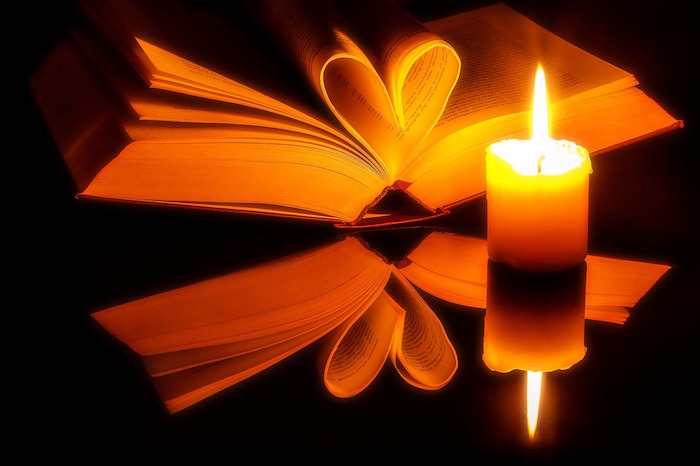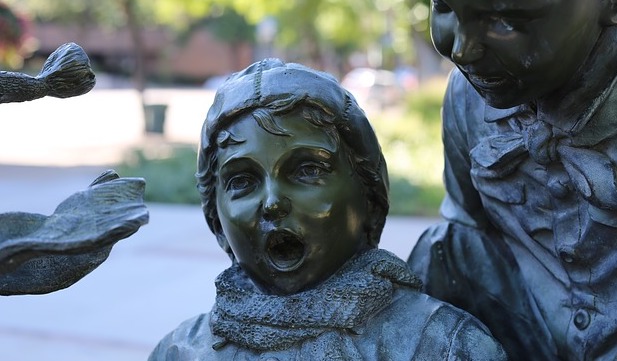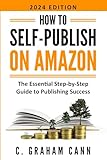Writing Poetry, Part 1
What is verse, and how does it differ from prose? This short article introduces the subject of poetry to writers.

A columned entry shone and marble stairs.
These lines, you observe, are merely descriptive; it is not poetic thought or feeling that keeps them from being prose. Neither is it rhyme; they are unrhymed. It is something else. Notice, in reading them aloud, that they have a certain swing not found in this: "Above the belt of blossoms in the garden shone a columned entry and marble stairs." Now let us see what produces that swing. We all know that two-syllabled words have an accent on one syllable. Try marking the accents on those in these lines, thus :
A col'-umned en'-try shone and mar'-ble stairs.
Next let us observe the words of one syllable: "the, belt, a, shone, and, stairs." Now "the" is a word not usually spoken with emphasis; we naturally give it no more stress than we do an unaccented syllable, such as "den" in "garden." The same is true of "a," also of "and." They may all be considered as unaccented, or weak, syllables. "Shone," "belt" and "stairs," however, are more important in meaning and sound, and serve here as accented, or strong, syllables ; we naturally read them so, and may mark them as such:
A col'-umned en'try shone' and mar'-ble stairs'.
Now observe the order in which the accented, or strong, syllables and the unaccented, or weak, ones come. Do you not find it a regular order, first a weak syllable, then a strong? It is this regularity of stress that gives the swing to the lines.
This, then, is what makes verse different from prose; a regular order of strong and weak syllables, which is called rhythm.
Read These Next
Booklets, Another Way to Sell Your Books
Consider turning your non-fiction book into a booklet outlining important concepts as a gateway to your full book.
Notes on the Romance Publishing Industry
On the top of popular fiction charts sits the often disrespected romance genre, but these stories of love and happily-ever-after manage to keep many publishers afloat, as readers purchase from publishers both large and small.
The Dangerous Side of Children’s Books
As an author, if you’re inspired to delve into the slightly dangerous, dark or subversive corners of childhood with your books, feel free to do so. Don’t limit yourself to all that’s bright, safe and up to code.







 Self-Publishing For Dummies (For Dummies: Learning Made Easy)
Self-Publishing For Dummies (For Dummies: Learning Made Easy) Self Publishing To Amazon KDP In 2023 - A Beginners Guide To Selling E-books, Audiobooks & Paperbacks On Amazon, Audible & Beyond
Self Publishing To Amazon KDP In 2023 - A Beginners Guide To Selling E-books, Audiobooks & Paperbacks On Amazon, Audible & Beyond Self-Publishing: The Secret Guide To Becoming A Best Seller (Self Publishing Disruption Book 2)
Self-Publishing: The Secret Guide To Becoming A Best Seller (Self Publishing Disruption Book 2) How to Self-Publish Your Book: A Complete Guide to Writing, Editing, Marketing & Selling Your Own Book
How to Self-Publish Your Book: A Complete Guide to Writing, Editing, Marketing & Selling Your Own Book Write. Publish. Repeat. (The No-Luck-Required Guide to Self-Publishing Success)
Write. Publish. Repeat. (The No-Luck-Required Guide to Self-Publishing Success) Self Publishing To Amazon KDP In 2024 - A Beginners Guide To Selling E-books, Audiobooks & Paperbacks On Amazon, Audible & Beyond
Self Publishing To Amazon KDP In 2024 - A Beginners Guide To Selling E-books, Audiobooks & Paperbacks On Amazon, Audible & Beyond How to Self-Publish on Amazon: The Essential Step-by-Step Guide to Publishing Success
How to Self-Publish on Amazon: The Essential Step-by-Step Guide to Publishing Success 14 Steps to Self-Publishing a Book
14 Steps to Self-Publishing a Book Self-Publisher's Legal Handbook: Updated Guide to Protecting Your Rights and Wallet
Self-Publisher's Legal Handbook: Updated Guide to Protecting Your Rights and Wallet How To Self-Publish A Children's Book: Everything You Need To Know To Write, Illustrate, Publish, And Market Your Paperback And Ebook
How To Self-Publish A Children's Book: Everything You Need To Know To Write, Illustrate, Publish, And Market Your Paperback And Ebook